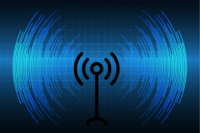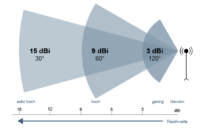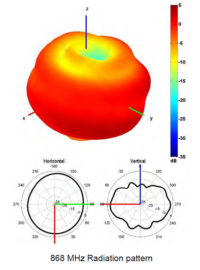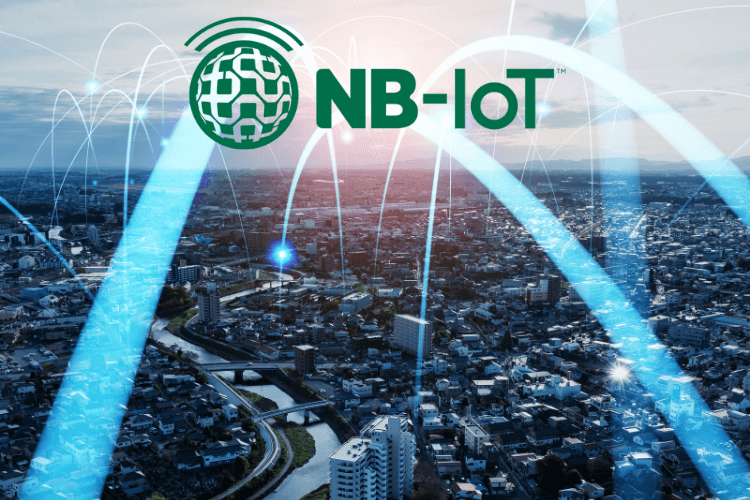LoRaWAN antenna: Everything you need to know about selection and optimum network coverage

In the world of the Internet of Things (IoT), LoRaWAN plays a central role in networking devices over long distances with minimal energy. Whether in agriculture, urban environments or industrial applications, the robustness and efficiency of LoRaWAN make it an ideal choice. But did you know that choosing the right LoRaWAN antenna is crucial to the effectiveness of your network?
In this article you will learn everything you need to know about LoRaWAN antennas, their selection and installation to optimize the performance of your IoT solutions.
What is a LoRaWAN antenna used for?
A LoRaWAN antenna mediates between the end device and the LoRaWAN network. Due to the low frequencies in which LoRaWAN operates, appropriate antennas increase the range (performance). This means that you can improve network coverage with the right antenna.
Different types of LoRaWAN antennas
There are a variety of different antenna types that can be used in conjunction with LoRaWAN. A basic distinction is made between the following types, with each variant offering specific advantages and disadvantages:
Omnidirectional antennas
These antennas, also known as omnidirectional antennas, radiate the signal evenly in all directions and are ideal for use in locations where 360-degree coverage is required. They are often used for gateways that need to reach many end devices from different directions
Directional antennas
Directional antennas (such as panel antennas) concentrate the signal in a specific direction. As a result, they can significantly increase the range, but are less flexible as they have to be precisely aligned. These antennas are ideal when it comes to addressing remote LoRaWAN end devices.
Embedded or PCB antennas
These antennas are often integrated directly into IoT devices and offer a space-saving solution. They are typically less powerful than external antennas, but are suitable for applications where device size plays an important role.
Important factors when choosing a LoRa antenna
Several factors influence the range of LoRaWAN antennas. However, the transmission power and reception sensitivity of the LoRaWAN gateway or end device used also play a key role. A good antenna can significantly improve the range by amplifying the signal and minimizing interference. When selecting a LoRaWAN antenna, it is important to pay attention to the frequency range, the gain (measured in dBi) and the directivity. Antennas with higher gain concentrate the signal energy better and increase the range, while the correct frequency ensures that the antenna is compatible with the region-specific LoRaWAN network.
Important selection criteria
| Feature | Explanation |
|---|---|
| Frequency (MHz) | Just like the other components of a LoRaWAN network, the antenna must also transmit and receive in the usual frequency range for the region. In Europe, for example, this is 868 MHz and in the USA 915 MHz. The frequency range therefore depends solely on the region. |
| VSWR (Voltage Standing Wave Ratio) | The VSWR indicates how well a LoRaWAN antenna is tuned to the radio frequency that it is supposed to transmit or receive. A low VSWR value indicates that the antenna is working efficiently by radiating as much of the fed-in power as possible and reflecting as little as possible. VSWR = 1:1: Ideal value - 100% of the power is radiated. VSWR < 1.5:1: Very good range, common target for LoRaWAN antennas. VSWR > 2:1: Less optimal - more energy is reflected, which can lead to power loss and potential damage to the transmitter. A low VSWR value therefore means better tuning and efficiency of the antenna and is crucial for stable, low-loss connections. |
| Antenna gain (dBi) | The antenna gain, measured in dBi, influences the range. Higher dBi values improve the range, but reduce the coverage across the width. Typical LoRaWAN antennas have values between 3 and 12 dBi, depending on the application. In urban environments with dense development, smaller antennas with values between 2-5 dBi are more suitable. Omnidirectional antennas are often preferred here. In rural areas or in open spaces without higher obstacles, larger antennas with higher dBi values of between 6-12 dBi tend to be used, as they scatter the signals better in a specific direction. |
| Beam width or beam angle | The beamwidth of a LoRaWAN antenna describes the aperture angle within which the radiated power reaches at least half of the maximum value. It indicates how "wide" or "focused" the signal radiates in a certain direction and is specified in degrees (e.g. 30°, 60°, 120°). |
| Polarization | Polarization describes the orientation of the electromagnetic waves that the antenna emits or receives. There are three main types: vertical, horizontal and circular or elliptical polarization. For optimum performance, it is important that the transmitter and receiver antennas have the same polarization, otherwise signal loss may occur. |
| Resistance (Ohm) | The resistance, or more precisely the impedance, indicates how strongly the antenna influences the electrical current flow at the desired frequency. The impedance is a complex value that includes both the ohmic resistance and the reactive resistance (consisting of capacitance and inductance). For most LoRaWAN systems, the standard impedance is 50 ohms. |
What is the relationship between radiation angle and antenna gain (dBi)?
The beam width determines the direction of propagation and range of the antenna. Narrow beam widths focus the signal for greater ranges, while wider beam widths provide more even coverage at close range. The correct beam width depends on the desired coverage and range of the LoRaWAN connection. For urban environments or areas with many obstacles, a wider beam width (omnidirectional pattern) can be useful to distribute the signal evenly. For long distances and clear lines of sight, narrow beam widths are ideal as they maximize performance and range.

- Narrower beam width (e.g. 30°-60°): A narrower beam width means a higher directional effect. The antenna focuses the signal in a specific direction and can achieve greater ranges. These types of antennas (often Yagi or panel antennas) are ideal for rural areas or point-to-point connections where signals need to be targeted.
- Wider beam width (e.g. 90°-120°): A wider beam width means that the signal is spread over a larger area, allowing for better coverage in the surrounding area. These types of antennas (often omnidirectional antennas) are ideal for urban areas or point-to-multipoint connections where blanket coverage is desired.

Radiation patterns of LoRaWAN antennas
The technical data sheets for LoRaWAN antennas usually include a graphic showing the radiation pattern. This three-dimensional pattern, known as the radiation pattern, shows how the radiated energy of the LoRa antenna is distributed in space, i.e. in which directions the signal is stronger or weaker. It helps to assess the range, coverage and effectiveness of the antenna for certain applications.

Other influencing factors
| Criterion | Explanation |
|---|---|
| Weather resistance | For outdoor applications, the antenna or antenna housing must be weatherproof. In this case, make sure that the housing complies with protection class IP67. These antennas withstand dust and water and are therefore suitable for adverse conditions. |
| Regulatory requirements | Compliance with regional regulations is necessary, especially with regard to the effective radiated power (EIRP) and the use of frequencies, in order to avoid interference. |
Tips for correct installation
For optimum performance, the LoRaWAN antenna should be installed as high as possible and without obstacles in order to make maximum use of the signal transmission. Installation on masts or roofs is common, as obstacles such as buildings or trees can reduce the range. Secure mounting is necessary to protect the antenna from wind and weather. You should also avoid interference from other electronic devices that could affect the signal strength. Align the antenna so that it points towards the main direction of reception. A slight tilt can sometimes improve the signal quality. Make sure that the antenna is protected against the weather to ensure long-term performance.
A LoRaWAN antenna installed outdoors should ideally have lightning protection to protect the antenna and the connected equipment from lightning strikes and surges.
Conclusion
LoRaWAN antennas are an integral part of optimizing IoT connectivity. Whether omnidirectional antennas for broad coverage or directional antennas for targeted signal amplification - each has its specific advantages and disadvantages.
Important factors such as antenna gain, the right frequency, the location and professional installation must be taken into account in order to achieve the best possible performance. A well-planned antenna selection and installation is the key to a successful LoRaWAN project.
You can find a selection of different LoRaWAN antennas in the m2m Germany Shop, for example.
Are you looking for a LoRaWAN antenna for your IoT project?
Do you have questions about which antenna is best suited to your specific application? Please contact us for an individual consultation!


